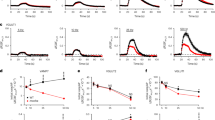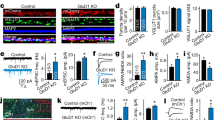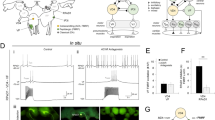Abstract
Receptors for excitatory amino-acid transmitters on nerve cells fall into two main categories associated with non-selective cationic channels, the NMDA (N-methyl-D-aspartate) and non-NMDA (kainate and quisqualate) receptors1,2. Special properties of NMDA receptors such as their voltage-dependent blockade by Mg2+ (refs 3,4) and their permeability to Na+, K+ as well as to Ca2+ (refs 5,6), have led to the suggestion that these receptors are important in plasticity during development and learning. They have been implicated in long-term potentiation7 (LTP), a model for the study of the cellular mechanisms of learning7–11. We report here that glutamate and NMDA, acting at typical NMDA receptors, stimulate the release of arachidonic acid (as well as 11- and 12-hydroxyeicosatetraenoic acids from striatal neurons probably by stimulation of a Ca2+-dependent phospholipase A2. Kainate and quisqualate, as well as K+-induced depolarization were ineffective. Our results provide direct evidence in favour of the hypothesis12,13, that arachidonic acid derivatives, produced by activation of the postsynaptic cell, could be messengers that cross the synaptic cleft to modify the presynaptic functions known to be altered during LTP9. In addition, we suggest that NMDA receptors are the postsynaptic receptors which trigger the synthesis of these putative transynaptic messengers.
This is a preview of subscription content, access via your institution
Access options
Subscribe to this journal
Receive 51 print issues and online access
$199.00 per year
only $3.90 per issue
Buy this article
- Purchase on Springer Link
- Instant access to full article PDF
Prices may be subject to local taxes which are calculated during checkout
Similar content being viewed by others
References
Watkins, J. C. & Evans, R. H. A. Rev. Pharmac. Tox. 21, 165–204 (1981).
Mayer, M. L. & Westbrook, G. L. Prog. Neurobiol. 28, 197–276 (1987).
Nowak, L., Bregestovski, P., Ascher, P., Herbet, A. & Prochiantz, A. Nature 307, 462–465 (1984).
Mayer, M. L. & Westbrook, G. L. J. Physiol., Lond. 354, 29–53 (1984).
Mayer, M. L., MacDermott, A. B., Westbrook, G. L., Smith, S. J. & Barker, J. L. J. Neurosci. 7, 3230–3244 (1987).
Murphy, S. N., Thayer, S. A. & Miller, R. J. J. Neurosci. 7, 4145–4158 (1987).
Collingridge, G. L., Kehl, S. J. & McLennan, H. J. Physiol., Lond. 334, 33–46 (1983).
Bliss, T. V. P. & Lomo, T. J. Physiol., Lond. 232, 331–356 (1973).
Bliss, T. V. P. & Gardner-Medwin, A. R. J. Physiol., Lond. 232, 357–374 (1973).
Andersen, P., Sunberg, S. H., Sveen, O. & Wigström, H. Nature 266, 736–337 (1977).
Dolphin, A. C., Errington, M. L. & Bliss, T. V. P. Nature 297, 496–498 (1982).
Piomelli, D. et al. Nature 328, 38–43 (1987).
Williams, J. H. & Bliss, T. V. P. Neurosci. Lett. 88, 81–85 (1988).
Weiss, S. et al. Proc. natn. Acad. Sci. U.S.A. 83, 2238–2242 (1986).
Watkins, J. C. & Olverman, H. J. Trends Neurosci. 10, 265–272.
Honey, C. R., Miljkovic, Z. & MacDonald, J. F. Neurosci. Lett. 61, 135–139 (1985).
Irvine, R. F. Biochem. J. 204, 3–16 (1982).
Van Rollins, M., Aveldano, M. I., Sprecher, H. W. & Horrocks, L. A. Meth. Enzym. 86, 518–530 (1982).
Pin, J. P., Van Vliet, B. J. & Bockaert, J. Neurosci. Lett. 87, 87–92 (1988).
MacDonald, J. F., Miljkovic, Z. & Pennefather, P. J. Neurophysiol. 58, 251–266 (1987).
Burch, R. M., Luini, A. & Axelrod, J. Proc. natn. Acad. Sci. U.S.A. 83, 7201–7205 (1986).
Linden, D. J., Sheu, F. S., Murakami, K. & Routtenberg, A. J. neurosci. 7, 3783–3792 (1987).
Sekiguchi, K., Tsukuda, M., Ogita, K., Kikkawa, U. & Nishizuka, Y. Biochem. biophys. Res. Commun. 145, 797–802 (1987).
Rhoads, D. E., Osburn, L. D., Peterson, N. A. & Raghupathy, E. J. Neurochem. 41, 531–537 (1983).
Chan, P. H., Kerlan, R. & Fishman, R. A. J. Neurochem. 40, 309–316 (1983).
Sladeczek, F., Pin, J. P., Récasens, M., Bockaert, J. & Weiss, S. Nature 317, 717–719 (1985).
Sugiyama, H., Ito, I. & Hirono, C. Nature 325, 531–533 (1987).
Nicoletti, F., Iadarola, M. J., Wroblewski, J. P. & Costa, E. Proc. natn. Acad. Sci. U.S.A. 83, 1931–1935 (1986).
Author information
Authors and Affiliations
Rights and permissions
About this article
Cite this article
Dumuis, A., Sebben, M., Haynes, L. et al. NMDA receptors activate the arachidonic acid cascade system in striatal neurons. Nature 336, 68–70 (1988). https://doi.org/10.1038/336068a0
Received:
Accepted:
Issue Date:
DOI: https://doi.org/10.1038/336068a0
This article is cited by
-
Large-scale interaction effects reveal missing heritability in schizophrenia, bipolar disorder and posttraumatic stress disorder
Translational Psychiatry (2017)
-
Garcinol prevents hyperhomocysteinemia and enhances bioavailability of L-DOPA by inhibiting catechol-O-methyltransferase: an in silico approach
Medicinal Chemistry Research (2016)
-
Polyunsaturated fatty acids and their metabolites in brain function and disease
Nature Reviews Neuroscience (2014)
-
The Role of Secretory Phospholipase A2 in the Central Nervous System and Neurological Diseases
Molecular Neurobiology (2014)
-
The Utility of 11C-Arachidonate PET to Study in vivo Dopaminergic Neurotransmission in Humans
Journal of Cerebral Blood Flow & Metabolism (2012)
Comments
By submitting a comment you agree to abide by our Terms and Community Guidelines. If you find something abusive or that does not comply with our terms or guidelines please flag it as inappropriate.



